Customer Data & Geotargeting

Level: Intermediate
Videos: 2
Length: 42min
To launch successful programmatic campaigns, it’s not just about placing ads—it’s about putting the right message in front of the right person at the right time. That starts with two foundational pillars: customer data and geotargeting.
In this lesson, we’ll explore how to:
- Leverage first-party and behavioral data to build high-performing audience segments
- Use precise geotargeting to reach consumers based on location, intent, and proximity to purchase
- Align your data strategy with personalized creatives and conversion-optimized landing pages
Whether you’re focused on local retail foot traffic, regional brand awareness, or nationwide visibility, dialing in your targeting strategy is key to maximizing reach, relevance, and ROI.
Four Critical Elements of Programmatic Campaigns:

What’s Your Ad Campaign Objective?
The first step when launching an ad campaign is to get clear on your goals. What is the desired outcome?
Your goal will shape your messaging, audience, and media strategy.
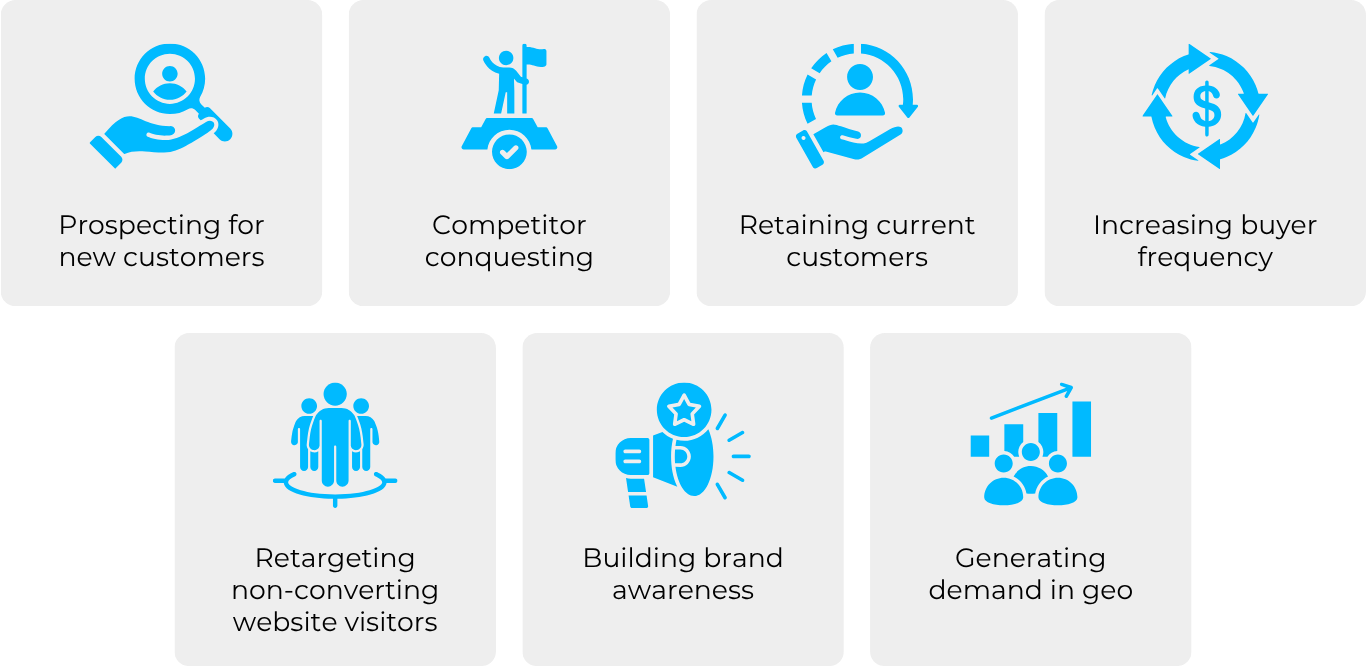
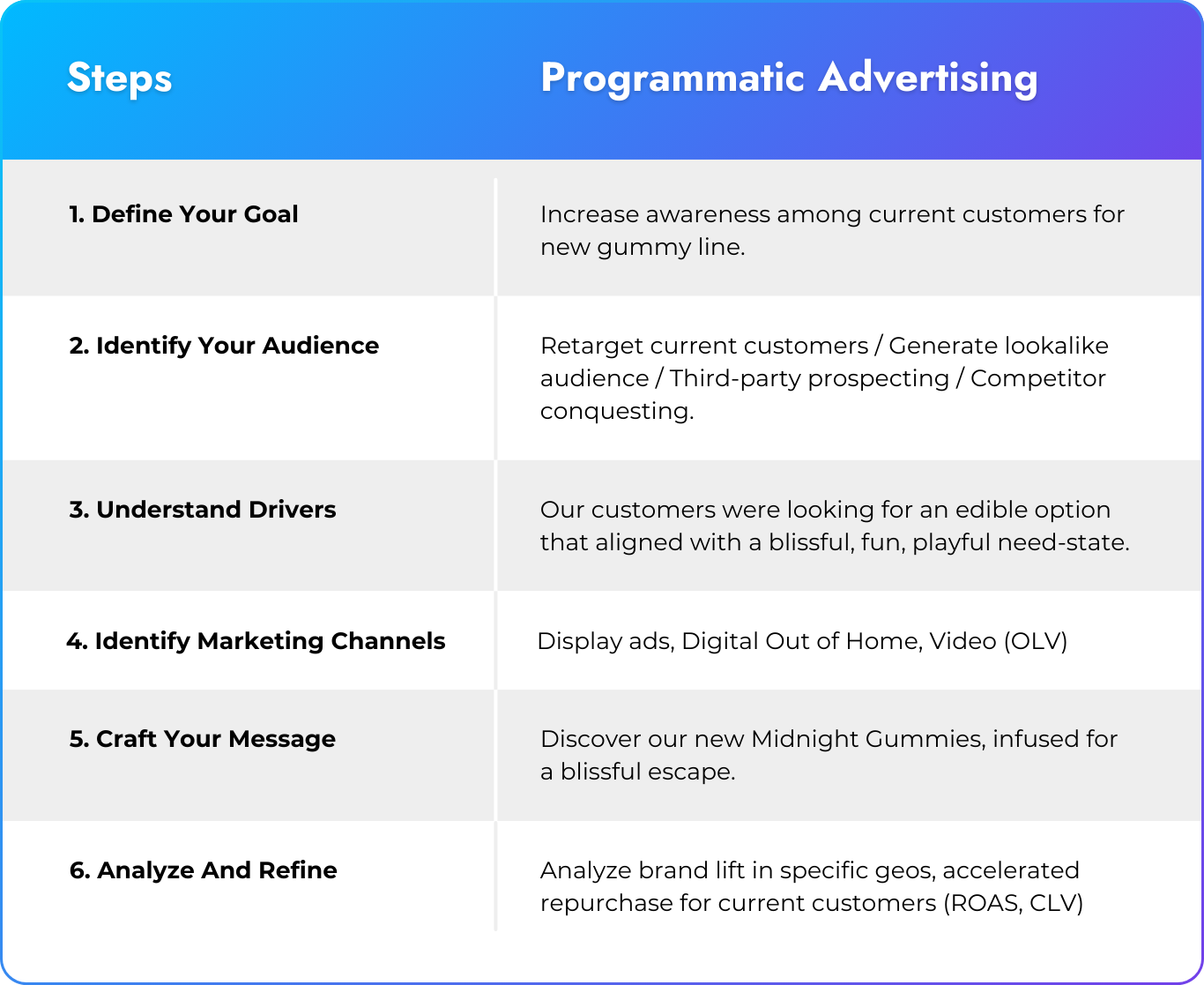
The Power of Data: Building Your Audiences
In today's competitive landscape, smart use of data is a major factor contributing to the success of paid advertising campaigns. As cannabis businesses navigate strict ad regulations and adapt to a rapidly evolving market, leveraging customer data is a game-changer. By effectively utilizing your first-party data and building third-party segments, you can efficiently target audiences who have a high propensity to purchase and create more personalized marketing campaigns that lower customer acquisition costs, improve your ROI, and enhance customer experience.
Don't waste your time and money on spray and pray strategies when you can laser-focus ad dollars on audiences who are ready to purchase. After all, the goal is to transform buyers into loyal brand advocates.
First-Party Data
First-party data is the information you gather from customers who interact with your business and fill out a form (think VIP loyalty or newsletters, or make a purchase). Analyzing and segmenting this data will help you get to know your customers better, customize your cannabis marketing, and enhance your services. Here are a few examples of what this data might include:
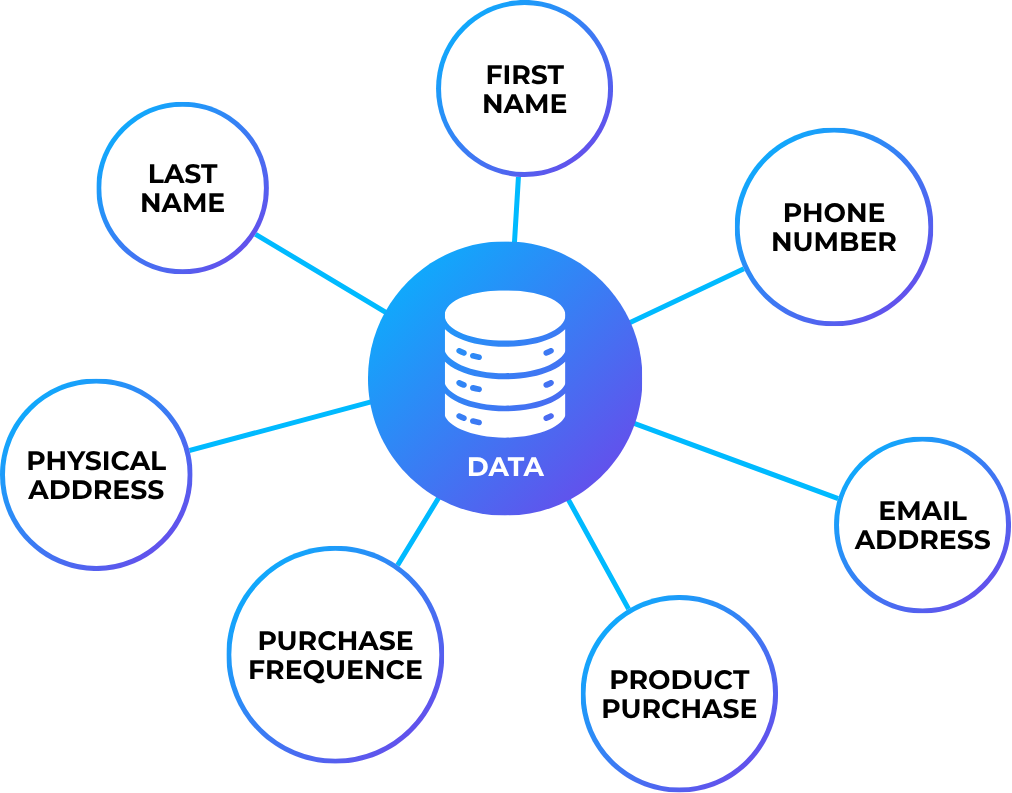
Lookalike Audiences
Lookalike audiences are a targeting tool used to reach new potential customers who share characteristics with an existing audience. By analyzing the behaviors, demographics, and interests of your first-party data (such as previous customers or website visitors), programmatic platforms can ingest first-party data and then identify other users with similar characteristics and behaviors to model lookalike audiences. This approach allows advertisers (you) to expand reach and prospect for new customers who are more likely to convert, thereby improving campaign performance and conversion rates.
Third-Party Data
Third-Party Data is information collected from various sources, not directly connected to the user. For example, third-party sources may include websites or political census polls where users input personal information. Their activity is then collected and aggregated by third parties. This data is used to create detailed audience segments based on demographics, interests, behaviors, and purchasing habits. Advertisers can use these segments to target their ads more precisely to users who are most likely to be interested in their products or services.
Third-party Data Benefits:
- Deeper Insights: Third-party data reveals behaviors and preferences your first-party data may miss, enabling more precise audience targeting.
- Wider Reach: Extend beyond your current audience to find new, high-potential customers—ideal for prospecting.
Behavioral and Transactional Data
Behavioral and transactional data provide critical insights into both what customers do and what they buy. Behavioral data reveals how individuals interact with your digital touchpoints—such as the keywords they search on Google, the websites they visit (including competitor sites), how frequently they return, which pages they view, how long they stay, what they click, and where they drop off.
On the other hand, transactional data captures the specifics of their purchase behavior—what products they've bought, how frequently they buy, how much they spend, which categories they prefer, and which payment methods they use.
When combined, transactional and behavioral data paint a comprehensive picture of your customer's journey. This data is key to uncovering funnel drop-offs, refining audience targeting, optimizing landing pages, and personalizing campaigns that increase conversions and customer lifetime value.
Device Identifiers: MAIDs and Cookies
To activate all of this customer data across devices and ad platforms, you need tools that help identify and reach the right users—this is where Mobile Advertising IDs (MAIDs) and cookies come into play.
- MAIDs are unique, anonymous identifiers tied to mobile devices. They allow advertisers to track and target individuals based on their app usage, location patterns, and engagement behavior—without relying on personal details.
- Cookies are small data files stored in a user’s browser. They track web behavior such as page views, cart activity, and time on site, enabling retargeting and personalized ad delivery.
Why Use Them?
Both MAIDs (Mobile Advertising IDs) and cookies are essential tools in digital advertising because they allow advertisers to track user activity and location to serve relevant ads and measure ad performance metrics effectively.
Using these identifiers, advertisers can:
- Deliver personalized ads that align with user preferences.
- Improve targeting accuracy, ensuring the right message reaches the right audience.
- Retarget users, encouraging them to take action or return to a website.
- Measure effectiveness by tracking conversions, engagement rates, click-through rates, and other key ad performance metrics.
These tools make it easier to create seamless, effective advertising experiences that drive better engagement and results.
Psychographic and Geographic Data
Psychographic data gives you a peek into your customers' interests, lifestyles, values, and attitudes. Geographic data, on the other hand, covers where they are—like their city, state, or region and even their IP addresses.
When you combine these insights, you can craft ideal customer profiles that inform your campaigns, brand voice, creatives, and other marketing messages. This ensures that they resonate with what your audience cares about and effectively target them based on their location and preferences.
Dive Deeper and check these blogs out:
- Cannabis Programmatic Ad Targeting: Contextual vs Behavioral
- The Value of Segmentation, Targeting, and Positioning in Dispensary Advertising
How to Use Customer Data to Refine Marketing Strategies
Segment your audience and personalize your messaging
Getting to know your audience is key to successful programmatic advertising, and that starts with smart audience segmentation. Picture this: you're launching a new bakery. Instead of baking every type of pastry and hoping for the best, you'd focus on what your local community actually wants—croissants for the early birds and cakes for birthdays and celebrations.
The same principle applies to your ads. Rather than taking a one-size-fits-all approach, audience segmentation allows you to tailor campaigns to specific groups based on their interests, behaviors, demographics, and more. This targeted approach helps you deliver more relevant messaging and maximize the performance of every ad impression.
Defining Your Ideal Customer
Let's discuss how to define your ideal customer step-by-step so that your advertising efforts can be more effective and targeted.
Start with Basic Demographics
Begin by identifying the basic demographic characteristics of your ideal customer. These include:
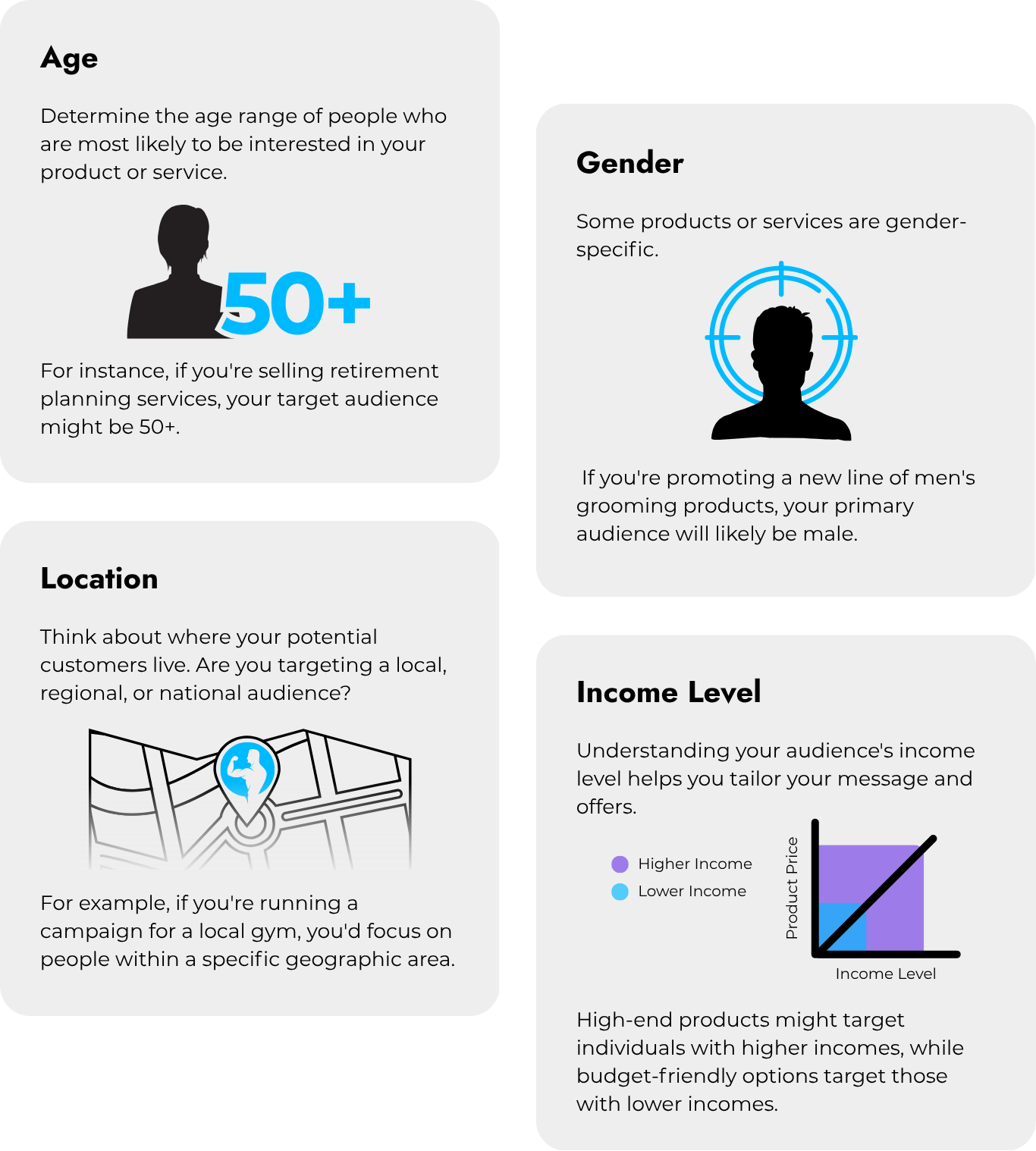
Explore Psychographics
Beyond demographics, psychographics delve into the lifestyle, interests, and values of your ideal customer:

Identify Pain Points and Needs
Understanding your audience's challenges and needs helps you craft messages that resonate:
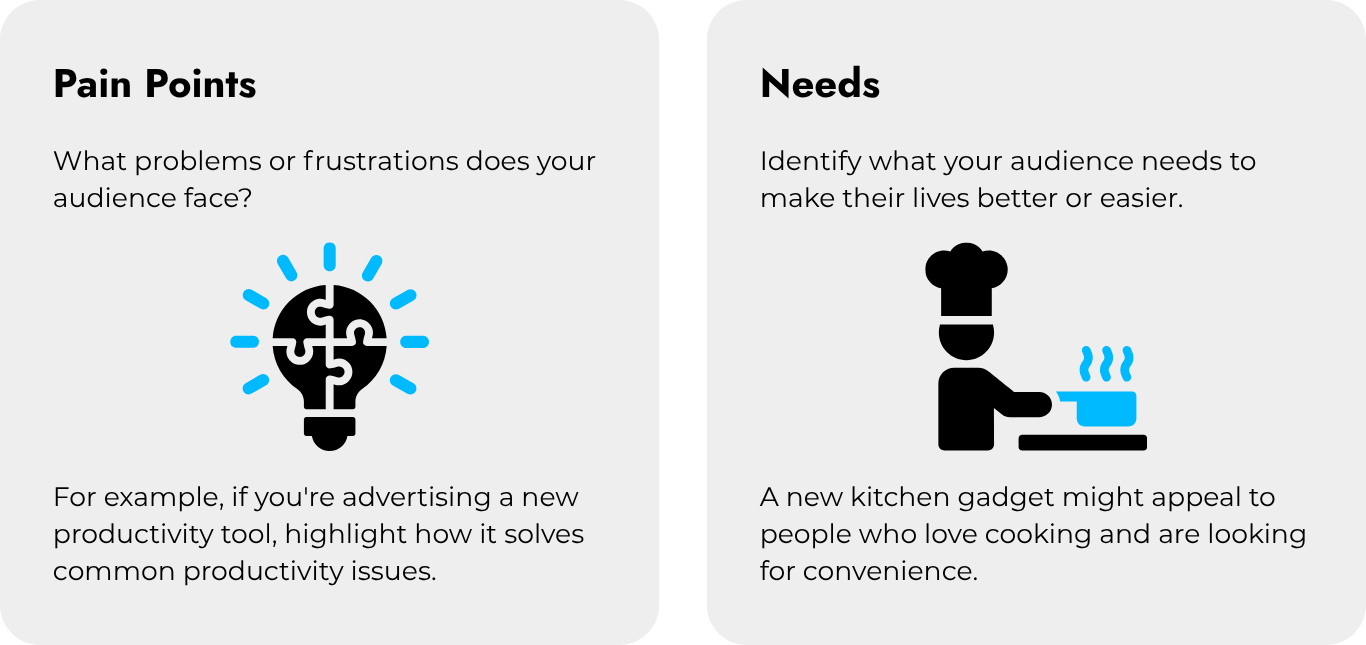
Analyze Customer Data
Leverage existing customer data to refine your audience profile:
- Website Analytics: Tools like Google Analytics can reveal who's visiting your website, what pages they're viewing, and how they're interacting with your content.
- Social Media Insights: Platforms like Facebook and Instagram provide demographic and interest-based insights into who's engaging with your posts and ads.
- Customer Surveys: Direct feedback from customers can provide valuable information about their preferences and behaviors.
Create Customer Personas
A customer persona is a semi-fictional representation of your ideal customer. It helps in visualizing and targeting your audience more effectively:
- Name and Background: Give your persona a name and background story. For example, "Sarah, the 30-year-old urban professional who loves yoga."
- Goals and Challenges: Define her goals and challenges. Sarah's goals might include maintaining a healthy lifestyle, while her challenges could be finding time for yoga.
- Preferred Channels: Identify where your persona spends their time online. Does Sarah prefer Instagram for fitness inspiration or blogs for yoga tips?
Refine and Test
Refine your customer profile based on the data and insights you gather. Test your targeting strategies and adjust based on performance:
- A/B Testing: Run different versions of your ads to see which resonates more with your defined audience.
- Monitor Engagement: Track how well your ads perform with your target audience. Are they clicking through, engaging, and converting?
- Iterate: Use the insights from your testing to continuously refine your audience profile and improve your campaigns.
Example:
- Ad Headline: Elevate Your Wellness, Naturally 🌱
- Ad Image: A serene urban setting with a young woman relaxing in a cozy apartment, sipping CBD-infused tea with a backdrop of plants and soft natural light.
- Call to Action (CTA): Shop CBD Wellness Now
- Landing Page Content / Copy: Discover the calming power of CBD, crafted for those who live life to the fullest but need a moment to unwind. Our premium CBD products are designed with your wellness in mind, perfect for urban professionals who value natural, holistic solutions. Shop now and experience exclusive offers on our best-selling CBD oils, edibles, and more. Find your balance, naturally.
- Target Audience: Women aged 25-40 in urban areas, interested in wellness, natural remedies, and CBD products.
New vs Returning Customers
Our philosophy is that you should always serve ads to your current customers. Your competitors are actively trying to win them over, so it's crucial to keep them engaged. By including them in your marketing efforts, you can influence their buying habits, encouraging them to come back sooner or purchase more frequently.
Leverage data for retargeting
Retargeting is like giving your audience a friendly nudge. It's all about reconnecting with people who've already shown interest in your brand but haven't taken the final step yet. Imagine someone browses your site, checks out a few products, but leaves without buying. With retargeting, you can serve them ads featuring those exact items or similar ones, reminding them of what caught their eye. We will discuss this in detail below. Retargeting ads are 10 times more effective than prospecting campaigns in converting customers.
Use Geographic Data for Your Marketing Campaigns
By understanding your audience's geographic location, you can tailor your messaging, offers, and products to meet the specific needs and preferences of people in different regions. Think about the people who live, work, or travel in your area. This not only increases the relevance of your ads but also boosts engagement and conversion rates.
For instance, geographic targeting enables you to run localized campaigns that consider cultural nuances, local events, inventory, or even weather conditions. This approach can lead to higher customer satisfaction and loyalty because the marketing feels more personalized and considerate of the audience's immediate environment. Additionally, geographic data helps optimize ad spend by ensuring your budget is focused on areas with the highest potential ROI, reducing wasted impressions on less relevant audiences.
Geofencing vs. GeoFraming
Finding and reaching the right audience is key to any successful ad campaign, and geotargeting is a game-changer. With location-based data, you can serve up ads that are relevant to customers based on where they are located, living, traveling, or commuting in the area around your retail location, or within your shipping state. This means your campaigns become way more precise and impactful, hitting the right notes at the right time.
What is Geofencing
Geofencing is a precise way to use location-based data to engage with your audience. Imagine you draw a virtual fence around a physical location on a map—this could be around your cannabis dispensary or a popular local event. When someone with a smartphone or GPS-enabled device enters or exits this virtual boundary, it triggers a specific action (opening a website or app where your ads can be shown), and you can deliver a targeted ad or a special offer.
For example, if someone is hanging out or commuting near your dispensary and browsing an article online, playing Sudoku, or using a dating app, and they meet your target audience criteria, geographic targeting allows you to serve them a timely and relevant ad promoting your store, a flash sale, or a special discount. This precise location-based strategy ensures that your message reaches them in the moments that matter. You can even take it a step further: if they visit a nearby competitor’s location, geographic targeting enables you to trigger an ad with an enticing offer, nudging them to check out your store instead.
What is Geoframing
Geoframing involves capturing device IDs when people are in a certain location—think a concert or a sports event. You can set up a virtual boundary around the stadium or location and generate a lookback audience, using that information for future targeting or retargeting.

💡Pro Tip: This is a great tactic for events when your target audience is all in one location and then flies back to the states where they live. You can retarget ads on a nationwide scale to that group of people.
3 Geotargeting Advertising Strategies
Proximity Targeting
Proximity targeting is a savvy marketing approach that uses mobile location services to reach customers when they're near specific places, like your retail store.
Here's how it works: You set up a virtual "perimeter" around a location, and when people enter this area—let's say near the Bellagio Fountain in Vegas —they'll start seeing your ads on their devices. It's a smart way to engage potential customers when they are in town, or living and working near the Bellagio Fountain. Note that this doesn’t usually happen in real time—the delay is anywhere between 24 and 72 hours.
Competitor Targeting
Competitor targeting is a powerful tactic that serves ads to anyone that has walked into your competitor locations. This tactic helps you target known cannabis customers and find ways to draw them to your dispensary instead.
For example, if you're located in bustling San Francisco with plenty of competition around, competitor targeting lets you zero in on nearby rival retailers. This way, you can draw customers away from your competitors and into your own store with better offers, or products.
Landmark Targeting
Landmark targeting is a fantastic way to reach tourists by focusing on popular spots in your city. It's similar to proximity targeting, but it zooms in on those key places tourists are most likely to visit.
For instance, if you know tourists flock to the Seattle Space Needle during the summer, you can target these high-traffic areas to catch their attention.
Want to grab their interest right when they arrive in the city? Deliver ads in DOOH (Digital Out of Home) screens at the airport.
You can also set up a geofence around the airport to reach known cannabis users as soon as they land. Or, if you're aiming to attract them while they're exploring downtown, you can set up geofenced perimeters around popular hotels.
Time for a story…

The Whopper Detour Success Story: How Burger King Outsmarted McDonalds with Geofencing
In December 2018, Burger King launched the Whopper Detour to boost their new mobile app. The deal? Get a Whopper for just a penny if you were within 600 feet of a McDonald's and picked it up at a nearby Burger King. The result? The app soared to #1 on iOS and Android within two days, and the promotion grabbed over 3 billion media impressions.
How did they pull this off? Geofencing! It uses location-based technology to connect with people in specific areas, like those 600 feet from a McDonald's.
Geofencing is a game-changer for connecting with your audience on a more personal level. Whether you're a big cannabis brand or a single dispensary, it's a tool that can seriously boost your local marketing efforts through cannabis programmatic advertising.
Boost Conversions With Retargeting
Ever feel like you're missing out on potential customers who visit your site but don't stick around? Retargeting can help you bring those visitors back and turn them into loyal customers. Here's a quick guide on how to build your audience segments and use pixels to track and retarget effectively:
Building Retargeting Audience Segments
Think of your audience like a giant puzzle, and each segment is a unique piece. Start by dividing your visitors into categories based on their actions. For example, you might have segments for:
- New Visitors: People who have visited your site.
- Product Specific: Those who've purchased within a specific category or product type.
- Cart Abandoners: Visitors who added items to their cart but didn't complete a purchase.
- Previous Buyers: Customers who've made a purchase, but not within 60 days.
- Dormant Customers: Customers who haven't made a purchase in over 60 days.
Use Pixels to Collect Data
Pixels are necessary to help you track and understand what actions users take after interacting with your ads, such as visiting your website, making a purchase, or signing up for a newsletter. They allow you to gather data on user behavior, which is crucial for optimizing your programmatic campaigns. This data-driven approach helps you refine your targeting, improve ad performance, and maximize return on investment (ROI).
When you install a pixel on your website, it collects data on how users interact with your site. This data helps you:
- Track Visitor Behavior: See which pages they visit and what actions they take.
- Retarget with Precision: Build audience segments to serve relevant ads to people who've visited specific pages or purchased specific products. Learn more
- Measure Ad Effectiveness: Understand how well your campaigns are performing. (ROAS)
Create Customized Retargeting Campaigns
With your segments built, you can craft personalized ads that speak directly to each group. For example:
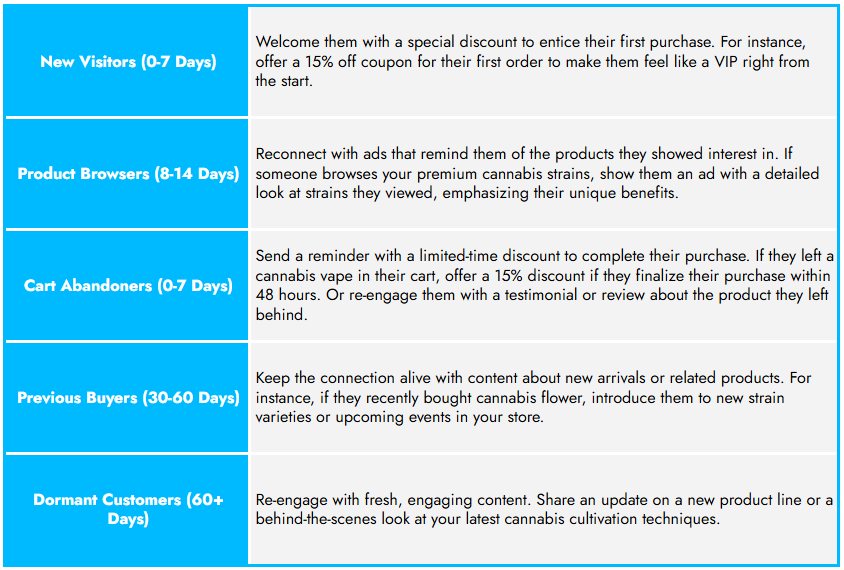
Creating customized retargeting campaigns not only enhances the user experience but also increases the likelihood of converting casual visitors into loyal customers. Remember, the key to successful retargeting lies in understanding your audience, segmenting them effectively, and delivering personalized, timely content that compels them to take action. With these strategies in place, you're well-equipped to turn missed opportunities into measurable successes.
The strategies and insights shared in this course are based on MediaJel’s extensive experience in cannabis marketing and programmatic advertising. Results may vary based on individual implementation, market conditions, and compliance requirements.
Videos
Welcome to our Academy video series, where learning is simple, engaging, and accessible. Each video is crafted to help you grow your skills, gain new insights, and stay inspired. No matter your background or goals, there’s something here for everyone.
Resources
Browse through our collection of helpful resources designed to support your learning. You'll find useful links, materials, and tools to explore at your own pace. These resources are here to enhance your experience and keep you moving forward.
Blogs
Services
Academy
Quiz
expand & engage retain & grow
From a dispensary launching in a local market to an established brand seeking to expand worldwide, programmatic can fuel your growth.
MediaJel is the industry’s digital marketing platform of choice for grow-focused brands and retailers like you.
Ready to accelerate?